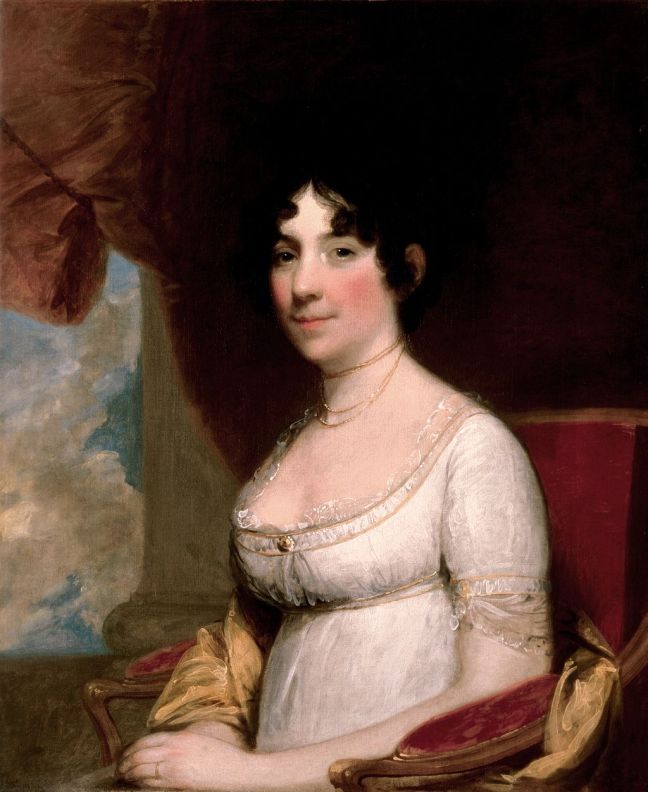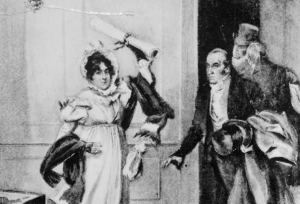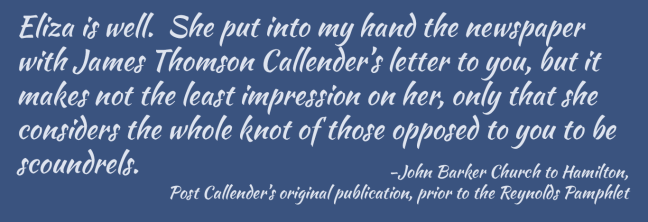Mr. Madison and “the Presidentess”
Listen, Dolley Madison is a gem of American History. If, thanks the Hamilton: An American Musical, you can credit A.Ham as an extremely important intellectual figure in the founding of the United States, you also must credit James Madison. He was the only one on par with Hamilton. Long story short: Madison is the best of the Virginians from his time period. I’ll make him his own post some day.
AND, other long story short, Madison really only politically succeeded because he was married to Dolley. In the musical he is very correctly portrayed as sickly and socially awkward. He was very small of stature. In real life, he wisely married Dolley and Dolley wisely married him.
Dolley’s success was her ability to charm and be sociable with everyone. It was a time, not unlike our own, where different political factions were viciously at each others’ throats. She did her damndest, as was very successful, at bridging those gaps and finding common ground. When Madison was in office, for example, she would have regular, weekly socials that people of all parties attended and were required to play nice. The gatherings became a staple of government workings–If you didn’t attend you weren’t in one of the most important rooms where things happened.

Hello, Dolley!
You love musicals and American history. You will hopefully agree with me that Dolly Gallagher Levi (of “Hello, Dolly!“) is in some capacity based on Mrs. Madison. The story is about a social butterfly widow who eventually makes a great marriage and alliance with a cranky, awkward fart…Not to mention that in the movie version starring Barbara Streisand, during THE song, the character is literally wearing peacock feathers all up in her hair. See below. And listen the song in a new tab while you think about Dolley Madison.
Quick aside about her being somewhat “sultry,” because the character in the musical is: Dolley Madison probably damn well was. Everyone loved her and she thrived because of it. The same types of vicious newspapers that plagued Hamilton and the others made big deal attempting to shame her for being allegedly promiscuous (pfft). Dolley Madison ignored all of it and did her thing.
Mood board, colors and fonts!

Basics
Color: #f9dd3f
Dolley-Yellow! I chose this color because she was a very sunny woman. She held the very first Inaugural Ball, and her dress was quite yellow. Also, after choosing this color I learned that when she was making the White House homey, she had a room painted in her “signature yellow color.” While it’s entirely possible I had this tidbit in the back of my mind somewhere and just forgot it, the point is that through and through Dolley’s color was yellow. That is her vibe.
Fonts: Sacramento, paired with Open Sans Condensed. A google fonts suggestion, because I’m still a newbie and I love google fonts. When I’m picking these I pretty much just browsed through, and Sacramento screamed Dolley’s personality to me. I decided to pair with Open Sans Condensed as a homage to her being with James Madison, so different and so much more uptight than her.
Images Context
Header Image: Montpelier, the historic home of James and Dolley Madison. I’ve visited it twice. Here’s the section of their site dedicated to Dolley. I’m also just going to take this moment to say that Dolley and James really did suck because they were mostly unrepentant slave owners. Yes it’s a sign of the times, but I hate George Washington for his hypocrisy on it, so I also hate them for it…Related image:
- Agriculture Field: By Adele Payman. Not actually Virginia, full disclosure.
Flag: By Stephanie McCabe. The most famous Dolley story is how she saved various Revolutionary War relics and the most famous portrait of George Washington during the invasion of Washington, DC during the war of 1812. She was someone who lived through the revolution, and then was the (“first”) First Lady when the British re-invaded.

Lady on Bed: By Vladislav Muslakov. She had a hard life, in addition to…you know…wars. Her first husband and second son (still an infant) died of yellow fever in 1793, leaving her a widow with her first son to support on her own at the age of 25. She definitely married James, in part, for financial security. In order to marry him, however, she had to accept being ousted by her religious community. She and her first husband were Quakers, and her marriage to a non-Quaker like James was a deal breaker for her church. (To be fair, she blossomed away from their restrictive lifestyle, but I digress…)
Lady and Son: By Daiga Ellaby. Her surviving son, Payne, was both the apple of her eye and a crap human being. He had serious gambling issues that James did his best to shield Dolley from while he was alive. However, after James died Payne’s debts became so insurmountable that Dolley was left destitute and had to sell Montpelier (including all of the slaves). Ultimately, by the end of her life she was incredibly poor thanks to her son. Regardless, she was always, always incredibly devoted to Payne. And, as a separate note, she was always very sad and disappointed that she and James were never managed to have their own children.
Peacock: By AGL Fotos. Dolley was a fashion icon. Big time. One of the first and biggest American fashion icons. She favored wearing her hair in a wrap/turban type getup with peacock feathers in it. It became all the rage. Also! Keep in mind that she came from that Quaker background where the standard was for her to dress extremely modestly. The quote about how she was “peculiarly fitted” to be the First Lady she eventually became is very apt. I will also take this time to mention that she so often took the spotlight (no doubt much to James’ relief) that she was referred to in the press as the “Presidentess.” Related to Hostess-Dolley:
- Tea: By rawpixel.
- Capitol Dome: By Neal Fagan. Because never forget that her motivation in playing this game was, in actuality, all about political power.
- Wine Glasses: By Michael Browning.
Lady on Stairs: By Bin Thiều. As mentioned, after James died Dolley was basically bankrupt by her leech of a son, Payne Todd. Eventually she moved back to DC, where she was at least somewhat socially comfortable. She and Eliza Hamilton became the two remaining “relics” of the Revolutionary War/the “founding fathers.” Basically, she was still revered, but privately she had a hard time paying the bills.
Notably, Dolley and Eliza Hamilton, living in similar (unfortunate) circumstances, were present at the dedication of the Washington Monument. A young Illinois House Representative named Abraham Lincoln was also in attendance!
Yellow Flowers Credit:
- By Huyen Nguyen.
- By Soragrit Wongsa.
- By Thomas William.























